Environmental Economics: Coal Extraction in Australia Analysis Report
VerifiedAdded on 2022/12/29
|11
|2894
|100
Report
AI Summary
This report delves into the environmental economics of coal extraction in Australia, focusing on the significant role of coal in the nation's economy and the environmental consequences of its extraction. It analyzes the ore reserves, production rates, and depletion levels of coal across states like New South Wales, Queensland, and Victoria, highlighting the potential for resource shortages. The report examines the high costs associated with coal extraction, including explosives, wages, and transportation, and discusses the concept of opportunity cost related to resource management. It explores the environmental challenges linked to coal mining, such as land subsidence, water and air pollution, and the impact on groundwater systems. The analysis includes an overview of the Hotelling rule, implications of extraction rates in terms of sustainable development and government policies aimed at mitigating environmental issues, such as the Suva Declaration and the New Greens policy. The report concludes by emphasizing the importance of efficient resource use and the need for regulatory measures to protect the environment and ensure the industry's sustainable growth.
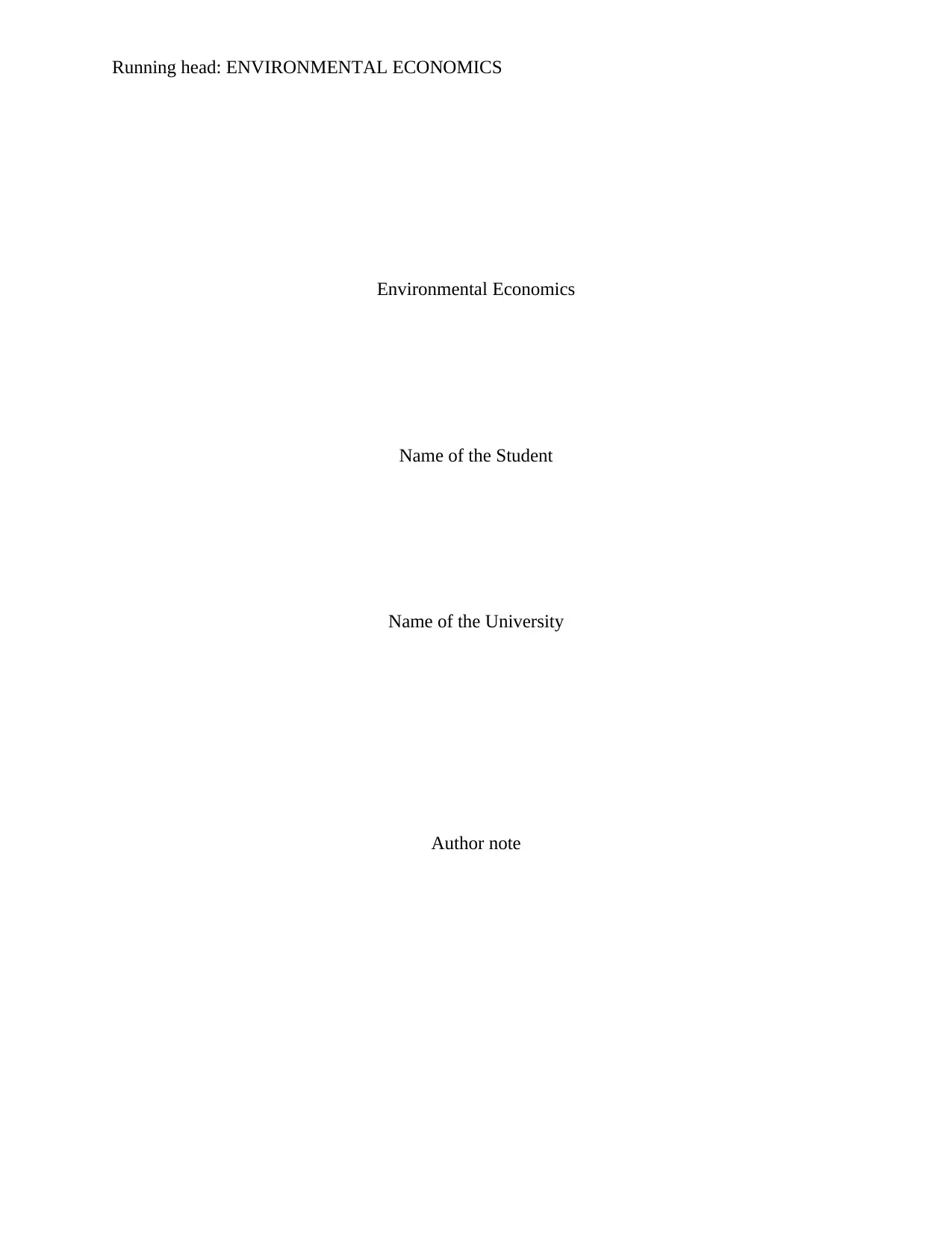
Running head: ENVIRONMENTAL ECONOMICS
Environmental Economics
Name of the Student
Name of the University
Author note
Environmental Economics
Name of the Student
Name of the University
Author note
Paraphrase This Document
Need a fresh take? Get an instant paraphrase of this document with our AI Paraphraser
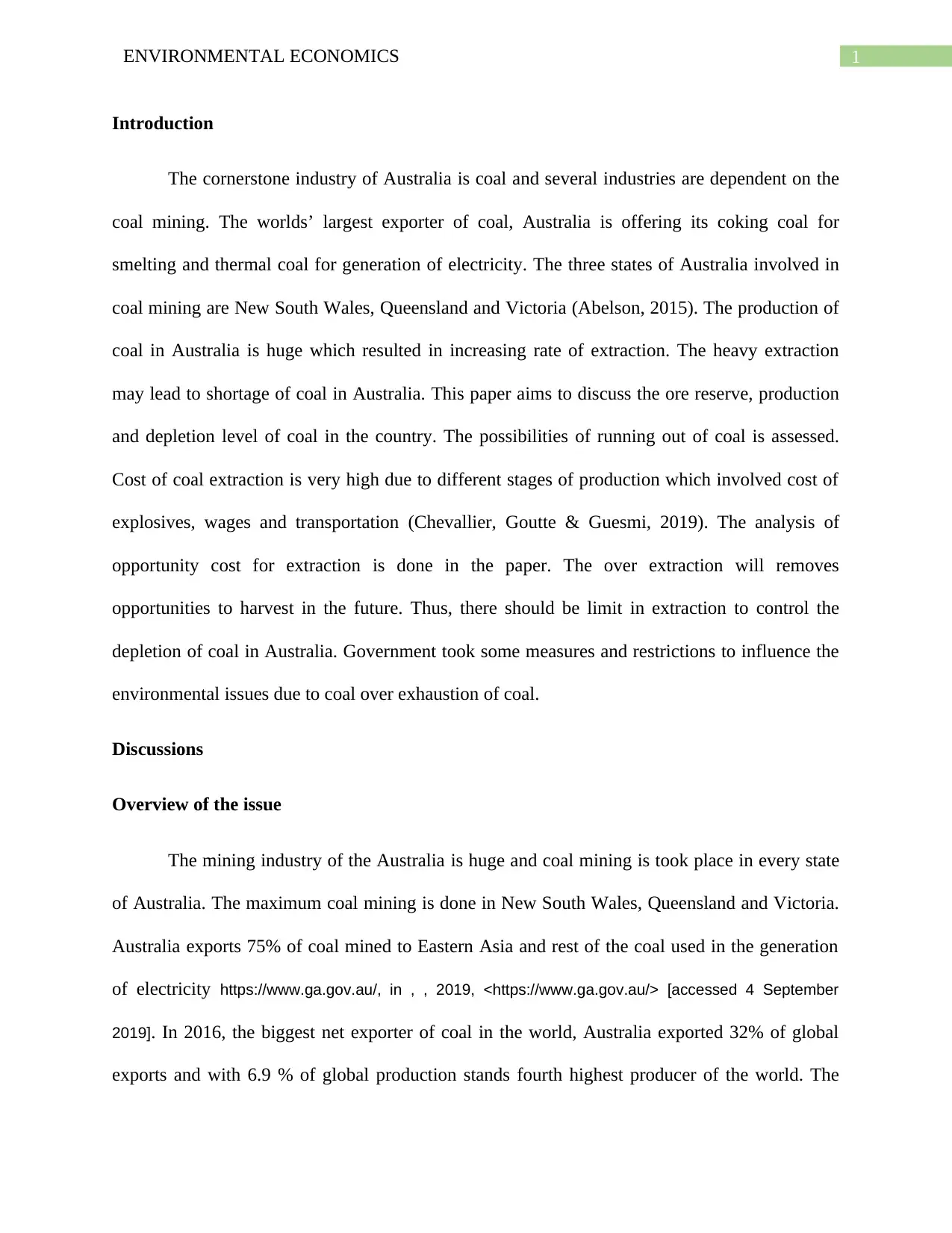
1ENVIRONMENTAL ECONOMICS
Introduction
The cornerstone industry of Australia is coal and several industries are dependent on the
coal mining. The worlds’ largest exporter of coal, Australia is offering its coking coal for
smelting and thermal coal for generation of electricity. The three states of Australia involved in
coal mining are New South Wales, Queensland and Victoria (Abelson, 2015). The production of
coal in Australia is huge which resulted in increasing rate of extraction. The heavy extraction
may lead to shortage of coal in Australia. This paper aims to discuss the ore reserve, production
and depletion level of coal in the country. The possibilities of running out of coal is assessed.
Cost of coal extraction is very high due to different stages of production which involved cost of
explosives, wages and transportation (Chevallier, Goutte & Guesmi, 2019). The analysis of
opportunity cost for extraction is done in the paper. The over extraction will removes
opportunities to harvest in the future. Thus, there should be limit in extraction to control the
depletion of coal in Australia. Government took some measures and restrictions to influence the
environmental issues due to coal over exhaustion of coal.
Discussions
Overview of the issue
The mining industry of the Australia is huge and coal mining is took place in every state
of Australia. The maximum coal mining is done in New South Wales, Queensland and Victoria.
Australia exports 75% of coal mined to Eastern Asia and rest of the coal used in the generation
of electricity https://www.ga.gov.au/, in , , 2019, <https://www.ga.gov.au/> [accessed 4 September
2019]. In 2016, the biggest net exporter of coal in the world, Australia exported 32% of global
exports and with 6.9 % of global production stands fourth highest producer of the world. The
Introduction
The cornerstone industry of Australia is coal and several industries are dependent on the
coal mining. The worlds’ largest exporter of coal, Australia is offering its coking coal for
smelting and thermal coal for generation of electricity. The three states of Australia involved in
coal mining are New South Wales, Queensland and Victoria (Abelson, 2015). The production of
coal in Australia is huge which resulted in increasing rate of extraction. The heavy extraction
may lead to shortage of coal in Australia. This paper aims to discuss the ore reserve, production
and depletion level of coal in the country. The possibilities of running out of coal is assessed.
Cost of coal extraction is very high due to different stages of production which involved cost of
explosives, wages and transportation (Chevallier, Goutte & Guesmi, 2019). The analysis of
opportunity cost for extraction is done in the paper. The over extraction will removes
opportunities to harvest in the future. Thus, there should be limit in extraction to control the
depletion of coal in Australia. Government took some measures and restrictions to influence the
environmental issues due to coal over exhaustion of coal.
Discussions
Overview of the issue
The mining industry of the Australia is huge and coal mining is took place in every state
of Australia. The maximum coal mining is done in New South Wales, Queensland and Victoria.
Australia exports 75% of coal mined to Eastern Asia and rest of the coal used in the generation
of electricity https://www.ga.gov.au/, in , , 2019, <https://www.ga.gov.au/> [accessed 4 September
2019]. In 2016, the biggest net exporter of coal in the world, Australia exported 32% of global
exports and with 6.9 % of global production stands fourth highest producer of the world. The
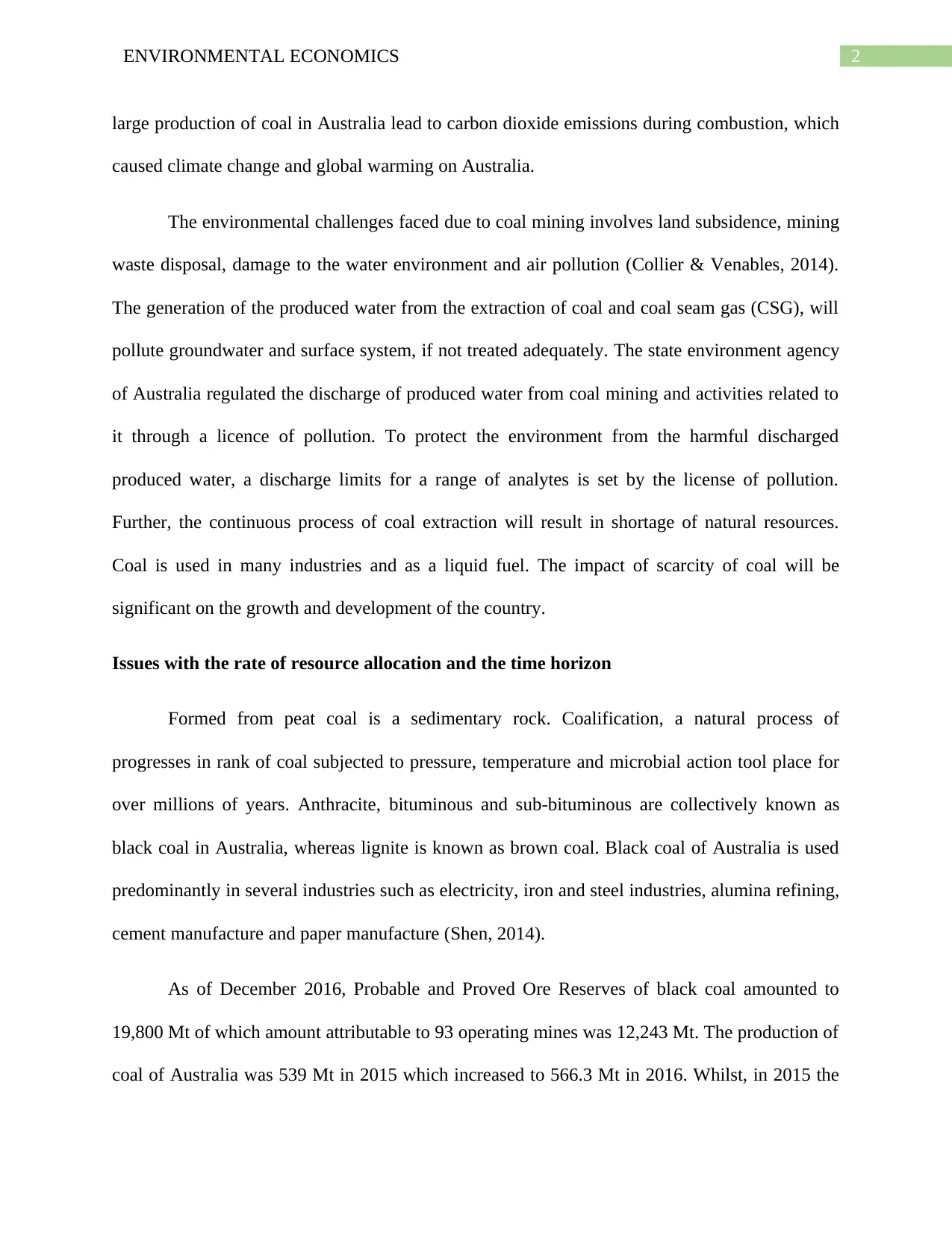
2ENVIRONMENTAL ECONOMICS
large production of coal in Australia lead to carbon dioxide emissions during combustion, which
caused climate change and global warming on Australia.
The environmental challenges faced due to coal mining involves land subsidence, mining
waste disposal, damage to the water environment and air pollution (Collier & Venables, 2014).
The generation of the produced water from the extraction of coal and coal seam gas (CSG), will
pollute groundwater and surface system, if not treated adequately. The state environment agency
of Australia regulated the discharge of produced water from coal mining and activities related to
it through a licence of pollution. To protect the environment from the harmful discharged
produced water, a discharge limits for a range of analytes is set by the license of pollution.
Further, the continuous process of coal extraction will result in shortage of natural resources.
Coal is used in many industries and as a liquid fuel. The impact of scarcity of coal will be
significant on the growth and development of the country.
Issues with the rate of resource allocation and the time horizon
Formed from peat coal is a sedimentary rock. Coalification, a natural process of
progresses in rank of coal subjected to pressure, temperature and microbial action tool place for
over millions of years. Anthracite, bituminous and sub-bituminous are collectively known as
black coal in Australia, whereas lignite is known as brown coal. Black coal of Australia is used
predominantly in several industries such as electricity, iron and steel industries, alumina refining,
cement manufacture and paper manufacture (Shen, 2014).
As of December 2016, Probable and Proved Ore Reserves of black coal amounted to
19,800 Mt of which amount attributable to 93 operating mines was 12,243 Mt. The production of
coal of Australia was 539 Mt in 2015 which increased to 566.3 Mt in 2016. Whilst, in 2015 the
large production of coal in Australia lead to carbon dioxide emissions during combustion, which
caused climate change and global warming on Australia.
The environmental challenges faced due to coal mining involves land subsidence, mining
waste disposal, damage to the water environment and air pollution (Collier & Venables, 2014).
The generation of the produced water from the extraction of coal and coal seam gas (CSG), will
pollute groundwater and surface system, if not treated adequately. The state environment agency
of Australia regulated the discharge of produced water from coal mining and activities related to
it through a licence of pollution. To protect the environment from the harmful discharged
produced water, a discharge limits for a range of analytes is set by the license of pollution.
Further, the continuous process of coal extraction will result in shortage of natural resources.
Coal is used in many industries and as a liquid fuel. The impact of scarcity of coal will be
significant on the growth and development of the country.
Issues with the rate of resource allocation and the time horizon
Formed from peat coal is a sedimentary rock. Coalification, a natural process of
progresses in rank of coal subjected to pressure, temperature and microbial action tool place for
over millions of years. Anthracite, bituminous and sub-bituminous are collectively known as
black coal in Australia, whereas lignite is known as brown coal. Black coal of Australia is used
predominantly in several industries such as electricity, iron and steel industries, alumina refining,
cement manufacture and paper manufacture (Shen, 2014).
As of December 2016, Probable and Proved Ore Reserves of black coal amounted to
19,800 Mt of which amount attributable to 93 operating mines was 12,243 Mt. The production of
coal of Australia was 539 Mt in 2015 which increased to 566.3 Mt in 2016. Whilst, in 2015 the
⊘ This is a preview!⊘
Do you want full access?
Subscribe today to unlock all pages.

Trusted by 1+ million students worldwide
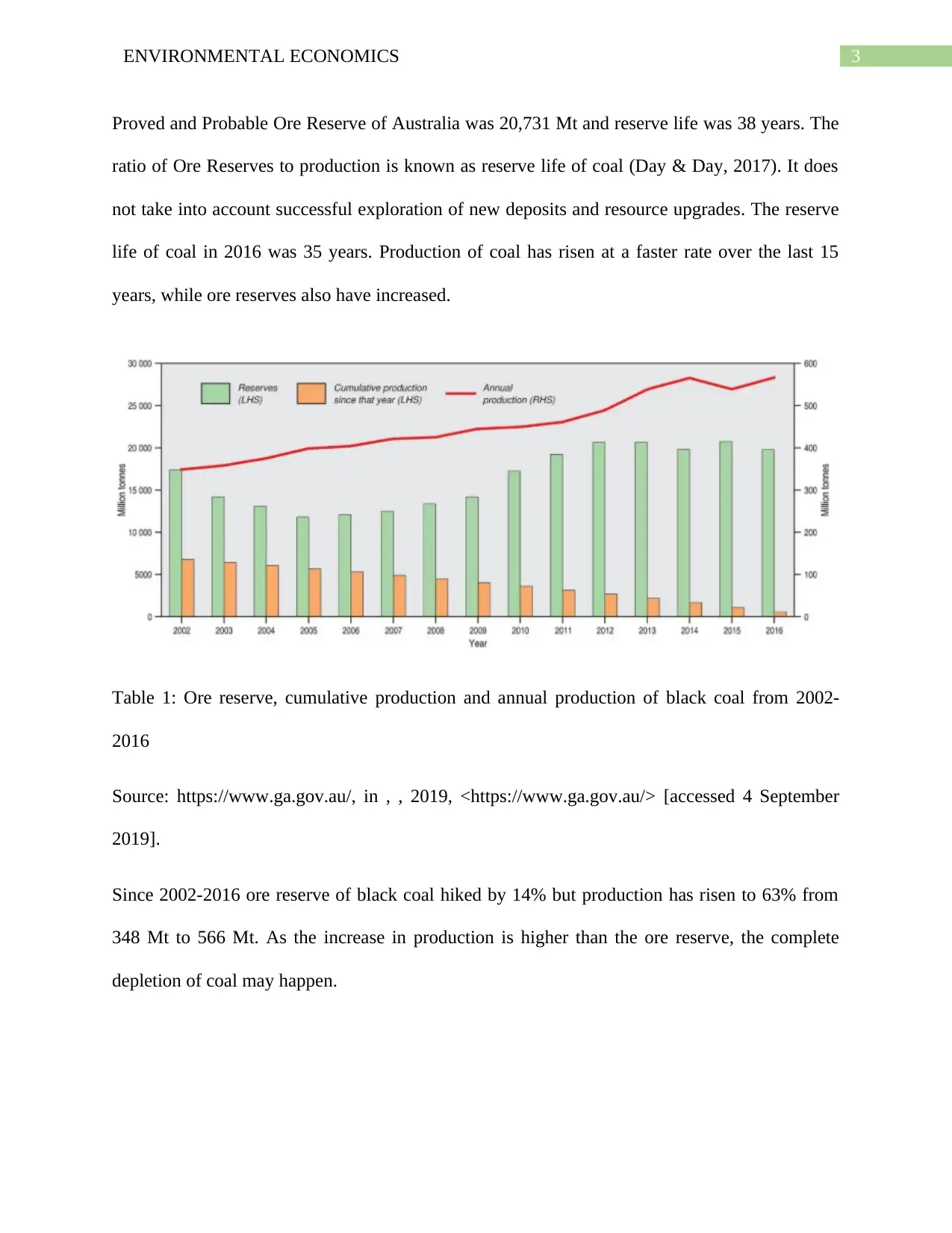
3ENVIRONMENTAL ECONOMICS
Proved and Probable Ore Reserve of Australia was 20,731 Mt and reserve life was 38 years. The
ratio of Ore Reserves to production is known as reserve life of coal (Day & Day, 2017). It does
not take into account successful exploration of new deposits and resource upgrades. The reserve
life of coal in 2016 was 35 years. Production of coal has risen at a faster rate over the last 15
years, while ore reserves also have increased.
Table 1: Ore reserve, cumulative production and annual production of black coal from 2002-
2016
Source: https://www.ga.gov.au/, in , , 2019, <https://www.ga.gov.au/> [accessed 4 September
2019].
Since 2002-2016 ore reserve of black coal hiked by 14% but production has risen to 63% from
348 Mt to 566 Mt. As the increase in production is higher than the ore reserve, the complete
depletion of coal may happen.
Proved and Probable Ore Reserve of Australia was 20,731 Mt and reserve life was 38 years. The
ratio of Ore Reserves to production is known as reserve life of coal (Day & Day, 2017). It does
not take into account successful exploration of new deposits and resource upgrades. The reserve
life of coal in 2016 was 35 years. Production of coal has risen at a faster rate over the last 15
years, while ore reserves also have increased.
Table 1: Ore reserve, cumulative production and annual production of black coal from 2002-
2016
Source: https://www.ga.gov.au/, in , , 2019, <https://www.ga.gov.au/> [accessed 4 September
2019].
Since 2002-2016 ore reserve of black coal hiked by 14% but production has risen to 63% from
348 Mt to 566 Mt. As the increase in production is higher than the ore reserve, the complete
depletion of coal may happen.
Paraphrase This Document
Need a fresh take? Get an instant paraphrase of this document with our AI Paraphraser
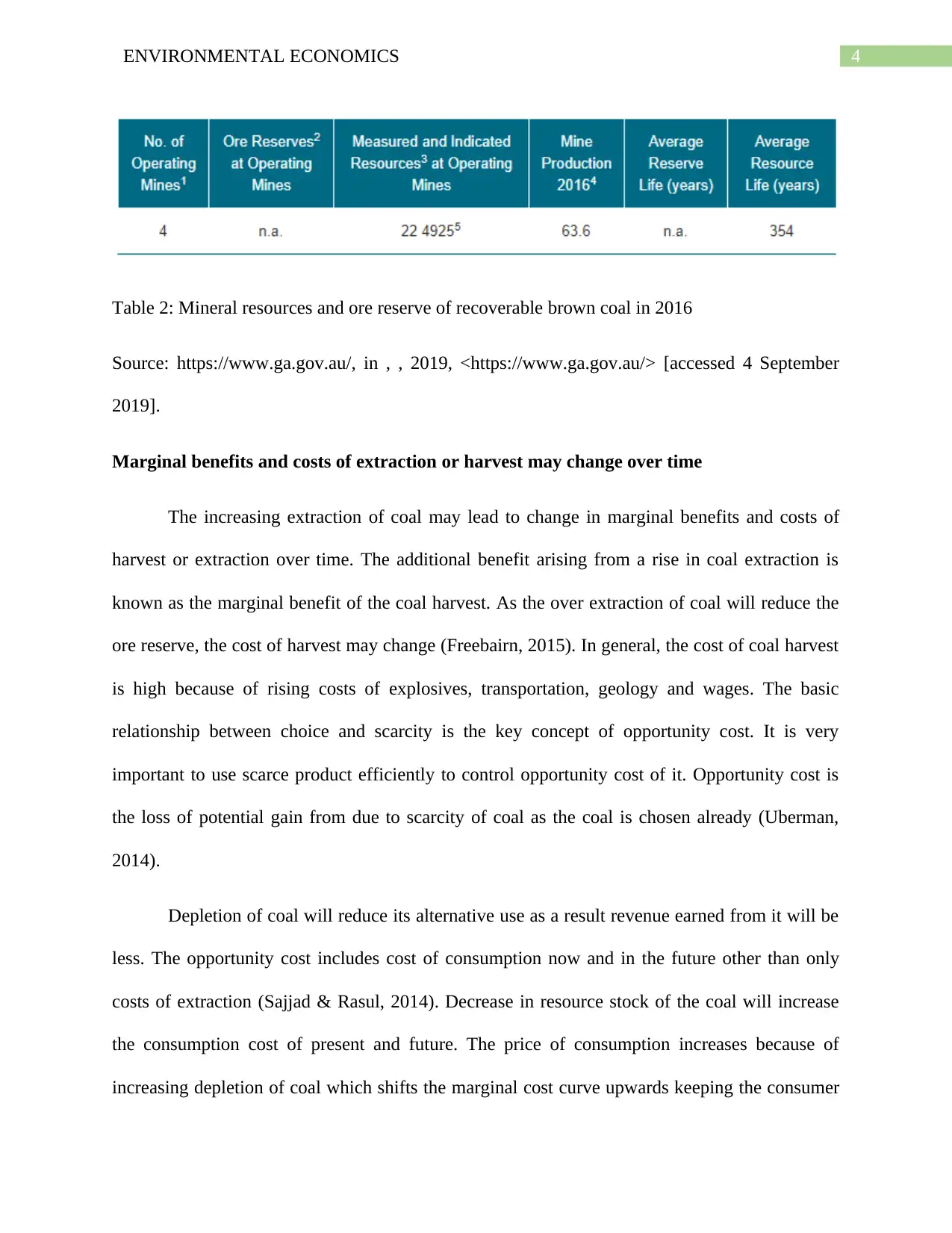
4ENVIRONMENTAL ECONOMICS
Table 2: Mineral resources and ore reserve of recoverable brown coal in 2016
Source: https://www.ga.gov.au/, in , , 2019, <https://www.ga.gov.au/> [accessed 4 September
2019].
Marginal benefits and costs of extraction or harvest may change over time
The increasing extraction of coal may lead to change in marginal benefits and costs of
harvest or extraction over time. The additional benefit arising from a rise in coal extraction is
known as the marginal benefit of the coal harvest. As the over extraction of coal will reduce the
ore reserve, the cost of harvest may change (Freebairn, 2015). In general, the cost of coal harvest
is high because of rising costs of explosives, transportation, geology and wages. The basic
relationship between choice and scarcity is the key concept of opportunity cost. It is very
important to use scarce product efficiently to control opportunity cost of it. Opportunity cost is
the loss of potential gain from due to scarcity of coal as the coal is chosen already (Uberman,
2014).
Depletion of coal will reduce its alternative use as a result revenue earned from it will be
less. The opportunity cost includes cost of consumption now and in the future other than only
costs of extraction (Sajjad & Rasul, 2014). Decrease in resource stock of the coal will increase
the consumption cost of present and future. The price of consumption increases because of
increasing depletion of coal which shifts the marginal cost curve upwards keeping the consumer
Table 2: Mineral resources and ore reserve of recoverable brown coal in 2016
Source: https://www.ga.gov.au/, in , , 2019, <https://www.ga.gov.au/> [accessed 4 September
2019].
Marginal benefits and costs of extraction or harvest may change over time
The increasing extraction of coal may lead to change in marginal benefits and costs of
harvest or extraction over time. The additional benefit arising from a rise in coal extraction is
known as the marginal benefit of the coal harvest. As the over extraction of coal will reduce the
ore reserve, the cost of harvest may change (Freebairn, 2015). In general, the cost of coal harvest
is high because of rising costs of explosives, transportation, geology and wages. The basic
relationship between choice and scarcity is the key concept of opportunity cost. It is very
important to use scarce product efficiently to control opportunity cost of it. Opportunity cost is
the loss of potential gain from due to scarcity of coal as the coal is chosen already (Uberman,
2014).
Depletion of coal will reduce its alternative use as a result revenue earned from it will be
less. The opportunity cost includes cost of consumption now and in the future other than only
costs of extraction (Sajjad & Rasul, 2014). Decrease in resource stock of the coal will increase
the consumption cost of present and future. The price of consumption increases because of
increasing depletion of coal which shifts the marginal cost curve upwards keeping the consumer
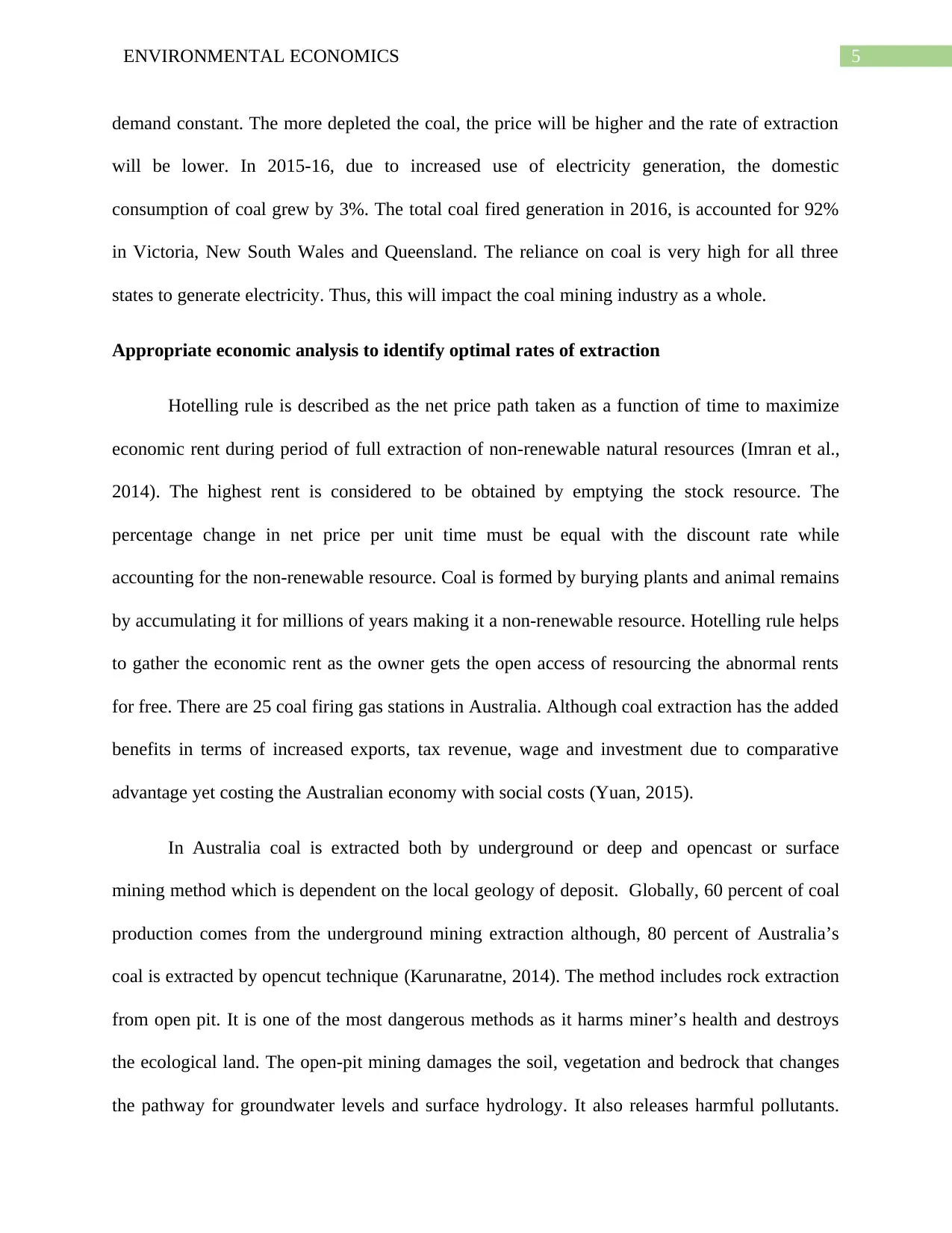
5ENVIRONMENTAL ECONOMICS
demand constant. The more depleted the coal, the price will be higher and the rate of extraction
will be lower. In 2015-16, due to increased use of electricity generation, the domestic
consumption of coal grew by 3%. The total coal fired generation in 2016, is accounted for 92%
in Victoria, New South Wales and Queensland. The reliance on coal is very high for all three
states to generate electricity. Thus, this will impact the coal mining industry as a whole.
Appropriate economic analysis to identify optimal rates of extraction
Hotelling rule is described as the net price path taken as a function of time to maximize
economic rent during period of full extraction of non-renewable natural resources (Imran et al.,
2014). The highest rent is considered to be obtained by emptying the stock resource. The
percentage change in net price per unit time must be equal with the discount rate while
accounting for the non-renewable resource. Coal is formed by burying plants and animal remains
by accumulating it for millions of years making it a non-renewable resource. Hotelling rule helps
to gather the economic rent as the owner gets the open access of resourcing the abnormal rents
for free. There are 25 coal firing gas stations in Australia. Although coal extraction has the added
benefits in terms of increased exports, tax revenue, wage and investment due to comparative
advantage yet costing the Australian economy with social costs (Yuan, 2015).
In Australia coal is extracted both by underground or deep and opencast or surface
mining method which is dependent on the local geology of deposit. Globally, 60 percent of coal
production comes from the underground mining extraction although, 80 percent of Australia’s
coal is extracted by opencut technique (Karunaratne, 2014). The method includes rock extraction
from open pit. It is one of the most dangerous methods as it harms miner’s health and destroys
the ecological land. The open-pit mining damages the soil, vegetation and bedrock that changes
the pathway for groundwater levels and surface hydrology. It also releases harmful pollutants.
demand constant. The more depleted the coal, the price will be higher and the rate of extraction
will be lower. In 2015-16, due to increased use of electricity generation, the domestic
consumption of coal grew by 3%. The total coal fired generation in 2016, is accounted for 92%
in Victoria, New South Wales and Queensland. The reliance on coal is very high for all three
states to generate electricity. Thus, this will impact the coal mining industry as a whole.
Appropriate economic analysis to identify optimal rates of extraction
Hotelling rule is described as the net price path taken as a function of time to maximize
economic rent during period of full extraction of non-renewable natural resources (Imran et al.,
2014). The highest rent is considered to be obtained by emptying the stock resource. The
percentage change in net price per unit time must be equal with the discount rate while
accounting for the non-renewable resource. Coal is formed by burying plants and animal remains
by accumulating it for millions of years making it a non-renewable resource. Hotelling rule helps
to gather the economic rent as the owner gets the open access of resourcing the abnormal rents
for free. There are 25 coal firing gas stations in Australia. Although coal extraction has the added
benefits in terms of increased exports, tax revenue, wage and investment due to comparative
advantage yet costing the Australian economy with social costs (Yuan, 2015).
In Australia coal is extracted both by underground or deep and opencast or surface
mining method which is dependent on the local geology of deposit. Globally, 60 percent of coal
production comes from the underground mining extraction although, 80 percent of Australia’s
coal is extracted by opencut technique (Karunaratne, 2014). The method includes rock extraction
from open pit. It is one of the most dangerous methods as it harms miner’s health and destroys
the ecological land. The open-pit mining damages the soil, vegetation and bedrock that changes
the pathway for groundwater levels and surface hydrology. It also releases harmful pollutants.
⊘ This is a preview!⊘
Do you want full access?
Subscribe today to unlock all pages.

Trusted by 1+ million students worldwide
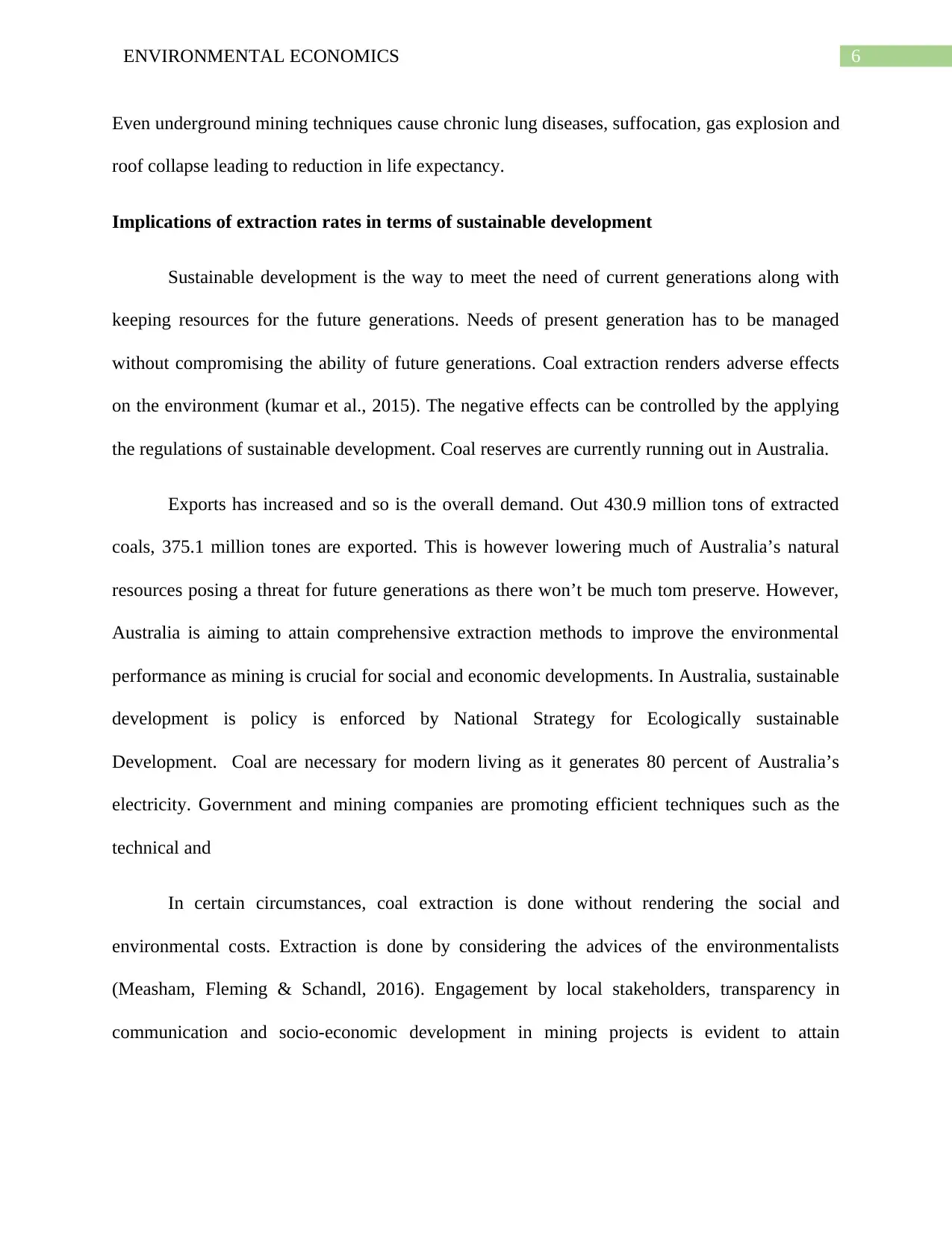
6ENVIRONMENTAL ECONOMICS
Even underground mining techniques cause chronic lung diseases, suffocation, gas explosion and
roof collapse leading to reduction in life expectancy.
Implications of extraction rates in terms of sustainable development
Sustainable development is the way to meet the need of current generations along with
keeping resources for the future generations. Needs of present generation has to be managed
without compromising the ability of future generations. Coal extraction renders adverse effects
on the environment (kumar et al., 2015). The negative effects can be controlled by the applying
the regulations of sustainable development. Coal reserves are currently running out in Australia.
Exports has increased and so is the overall demand. Out 430.9 million tons of extracted
coals, 375.1 million tones are exported. This is however lowering much of Australia’s natural
resources posing a threat for future generations as there won’t be much tom preserve. However,
Australia is aiming to attain comprehensive extraction methods to improve the environmental
performance as mining is crucial for social and economic developments. In Australia, sustainable
development is policy is enforced by National Strategy for Ecologically sustainable
Development. Coal are necessary for modern living as it generates 80 percent of Australia’s
electricity. Government and mining companies are promoting efficient techniques such as the
technical and
In certain circumstances, coal extraction is done without rendering the social and
environmental costs. Extraction is done by considering the advices of the environmentalists
(Measham, Fleming & Schandl, 2016). Engagement by local stakeholders, transparency in
communication and socio-economic development in mining projects is evident to attain
Even underground mining techniques cause chronic lung diseases, suffocation, gas explosion and
roof collapse leading to reduction in life expectancy.
Implications of extraction rates in terms of sustainable development
Sustainable development is the way to meet the need of current generations along with
keeping resources for the future generations. Needs of present generation has to be managed
without compromising the ability of future generations. Coal extraction renders adverse effects
on the environment (kumar et al., 2015). The negative effects can be controlled by the applying
the regulations of sustainable development. Coal reserves are currently running out in Australia.
Exports has increased and so is the overall demand. Out 430.9 million tons of extracted
coals, 375.1 million tones are exported. This is however lowering much of Australia’s natural
resources posing a threat for future generations as there won’t be much tom preserve. However,
Australia is aiming to attain comprehensive extraction methods to improve the environmental
performance as mining is crucial for social and economic developments. In Australia, sustainable
development is policy is enforced by National Strategy for Ecologically sustainable
Development. Coal are necessary for modern living as it generates 80 percent of Australia’s
electricity. Government and mining companies are promoting efficient techniques such as the
technical and
In certain circumstances, coal extraction is done without rendering the social and
environmental costs. Extraction is done by considering the advices of the environmentalists
(Measham, Fleming & Schandl, 2016). Engagement by local stakeholders, transparency in
communication and socio-economic development in mining projects is evident to attain
Paraphrase This Document
Need a fresh take? Get an instant paraphrase of this document with our AI Paraphraser
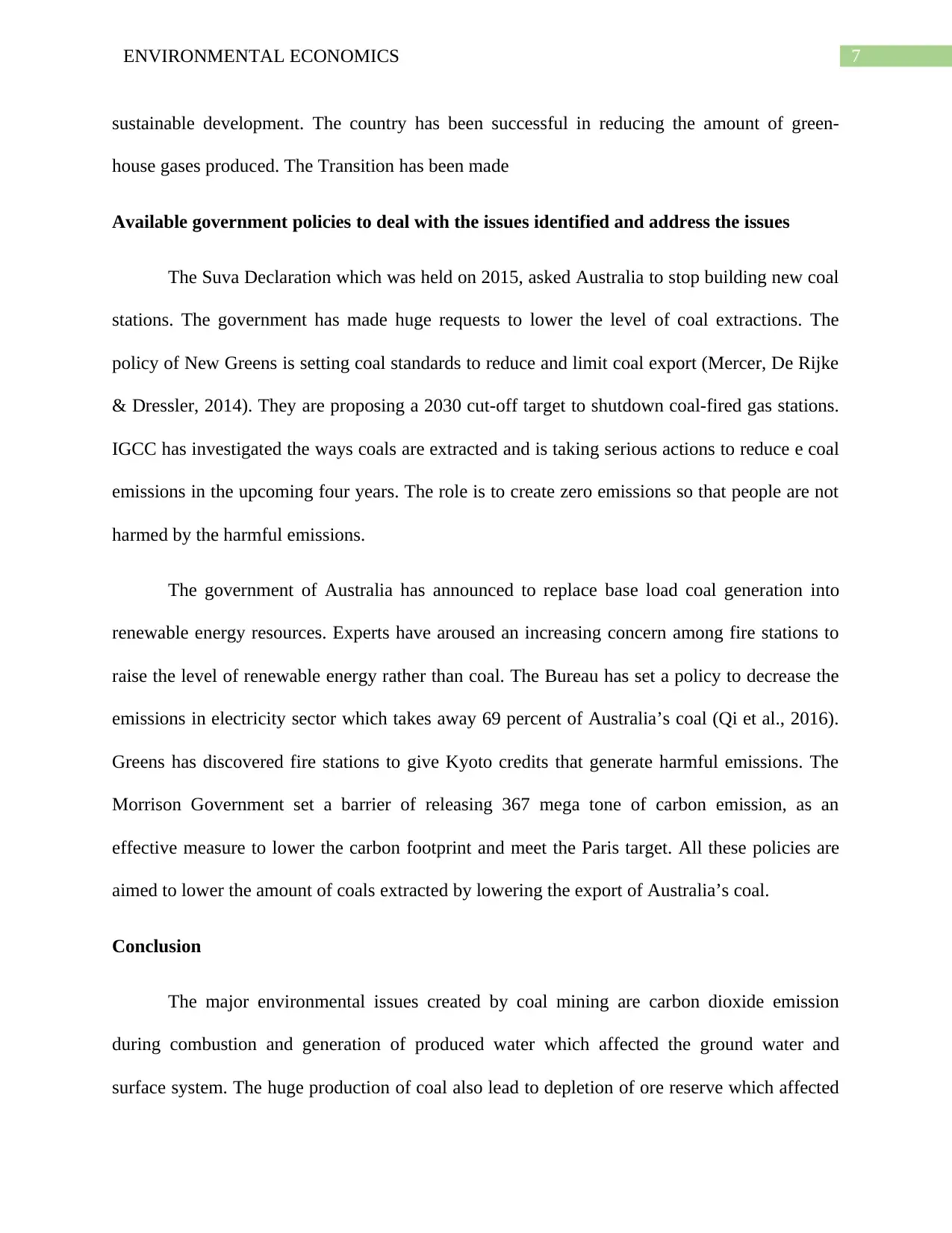
7ENVIRONMENTAL ECONOMICS
sustainable development. The country has been successful in reducing the amount of green-
house gases produced. The Transition has been made
Available government policies to deal with the issues identified and address the issues
The Suva Declaration which was held on 2015, asked Australia to stop building new coal
stations. The government has made huge requests to lower the level of coal extractions. The
policy of New Greens is setting coal standards to reduce and limit coal export (Mercer, De Rijke
& Dressler, 2014). They are proposing a 2030 cut-off target to shutdown coal-fired gas stations.
IGCC has investigated the ways coals are extracted and is taking serious actions to reduce e coal
emissions in the upcoming four years. The role is to create zero emissions so that people are not
harmed by the harmful emissions.
The government of Australia has announced to replace base load coal generation into
renewable energy resources. Experts have aroused an increasing concern among fire stations to
raise the level of renewable energy rather than coal. The Bureau has set a policy to decrease the
emissions in electricity sector which takes away 69 percent of Australia’s coal (Qi et al., 2016).
Greens has discovered fire stations to give Kyoto credits that generate harmful emissions. The
Morrison Government set a barrier of releasing 367 mega tone of carbon emission, as an
effective measure to lower the carbon footprint and meet the Paris target. All these policies are
aimed to lower the amount of coals extracted by lowering the export of Australia’s coal.
Conclusion
The major environmental issues created by coal mining are carbon dioxide emission
during combustion and generation of produced water which affected the ground water and
surface system. The huge production of coal also lead to depletion of ore reserve which affected
sustainable development. The country has been successful in reducing the amount of green-
house gases produced. The Transition has been made
Available government policies to deal with the issues identified and address the issues
The Suva Declaration which was held on 2015, asked Australia to stop building new coal
stations. The government has made huge requests to lower the level of coal extractions. The
policy of New Greens is setting coal standards to reduce and limit coal export (Mercer, De Rijke
& Dressler, 2014). They are proposing a 2030 cut-off target to shutdown coal-fired gas stations.
IGCC has investigated the ways coals are extracted and is taking serious actions to reduce e coal
emissions in the upcoming four years. The role is to create zero emissions so that people are not
harmed by the harmful emissions.
The government of Australia has announced to replace base load coal generation into
renewable energy resources. Experts have aroused an increasing concern among fire stations to
raise the level of renewable energy rather than coal. The Bureau has set a policy to decrease the
emissions in electricity sector which takes away 69 percent of Australia’s coal (Qi et al., 2016).
Greens has discovered fire stations to give Kyoto credits that generate harmful emissions. The
Morrison Government set a barrier of releasing 367 mega tone of carbon emission, as an
effective measure to lower the carbon footprint and meet the Paris target. All these policies are
aimed to lower the amount of coals extracted by lowering the export of Australia’s coal.
Conclusion
The major environmental issues created by coal mining are carbon dioxide emission
during combustion and generation of produced water which affected the ground water and
surface system. The huge production of coal also lead to depletion of ore reserve which affected
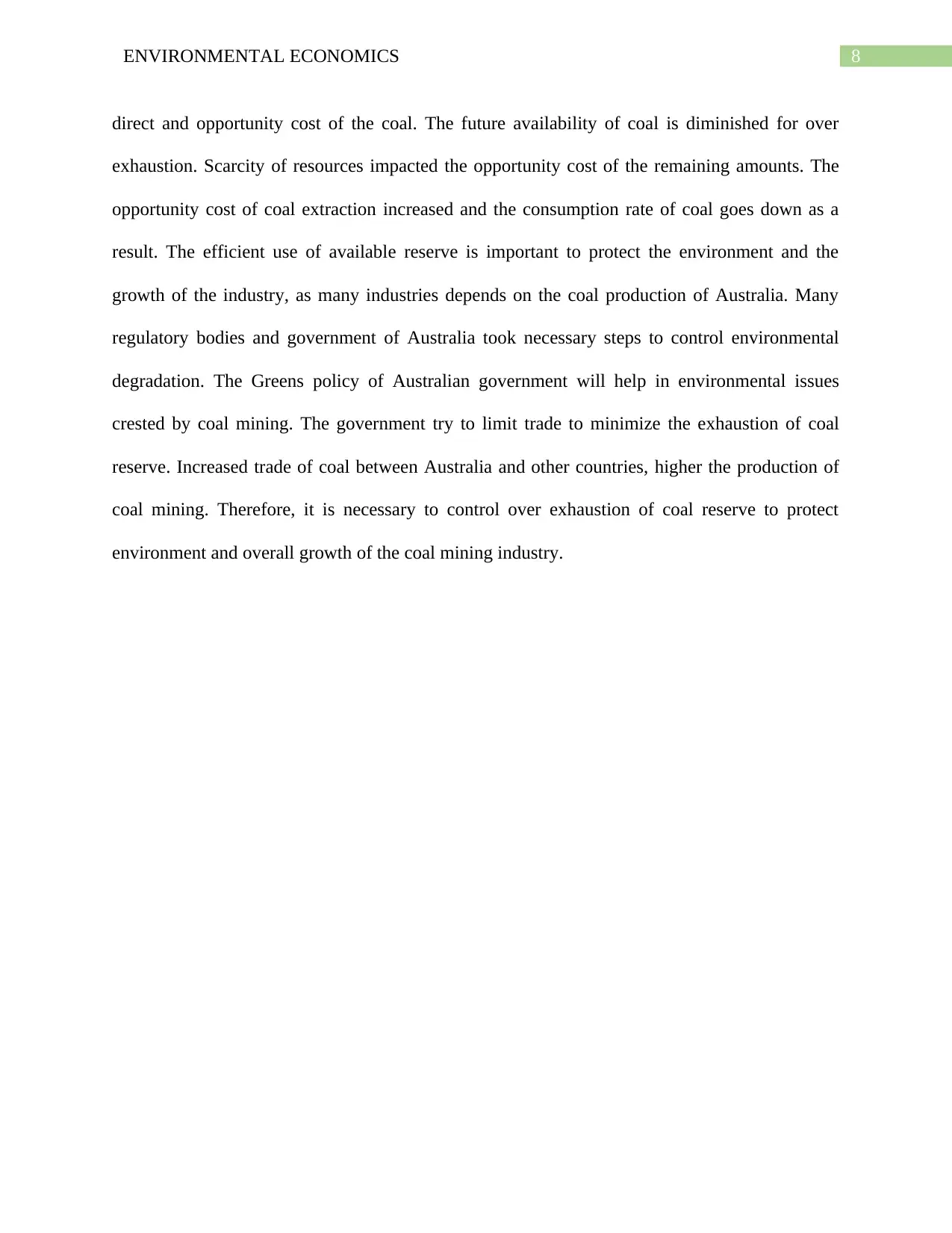
8ENVIRONMENTAL ECONOMICS
direct and opportunity cost of the coal. The future availability of coal is diminished for over
exhaustion. Scarcity of resources impacted the opportunity cost of the remaining amounts. The
opportunity cost of coal extraction increased and the consumption rate of coal goes down as a
result. The efficient use of available reserve is important to protect the environment and the
growth of the industry, as many industries depends on the coal production of Australia. Many
regulatory bodies and government of Australia took necessary steps to control environmental
degradation. The Greens policy of Australian government will help in environmental issues
crested by coal mining. The government try to limit trade to minimize the exhaustion of coal
reserve. Increased trade of coal between Australia and other countries, higher the production of
coal mining. Therefore, it is necessary to control over exhaustion of coal reserve to protect
environment and overall growth of the coal mining industry.
direct and opportunity cost of the coal. The future availability of coal is diminished for over
exhaustion. Scarcity of resources impacted the opportunity cost of the remaining amounts. The
opportunity cost of coal extraction increased and the consumption rate of coal goes down as a
result. The efficient use of available reserve is important to protect the environment and the
growth of the industry, as many industries depends on the coal production of Australia. Many
regulatory bodies and government of Australia took necessary steps to control environmental
degradation. The Greens policy of Australian government will help in environmental issues
crested by coal mining. The government try to limit trade to minimize the exhaustion of coal
reserve. Increased trade of coal between Australia and other countries, higher the production of
coal mining. Therefore, it is necessary to control over exhaustion of coal reserve to protect
environment and overall growth of the coal mining industry.
⊘ This is a preview!⊘
Do you want full access?
Subscribe today to unlock all pages.

Trusted by 1+ million students worldwide
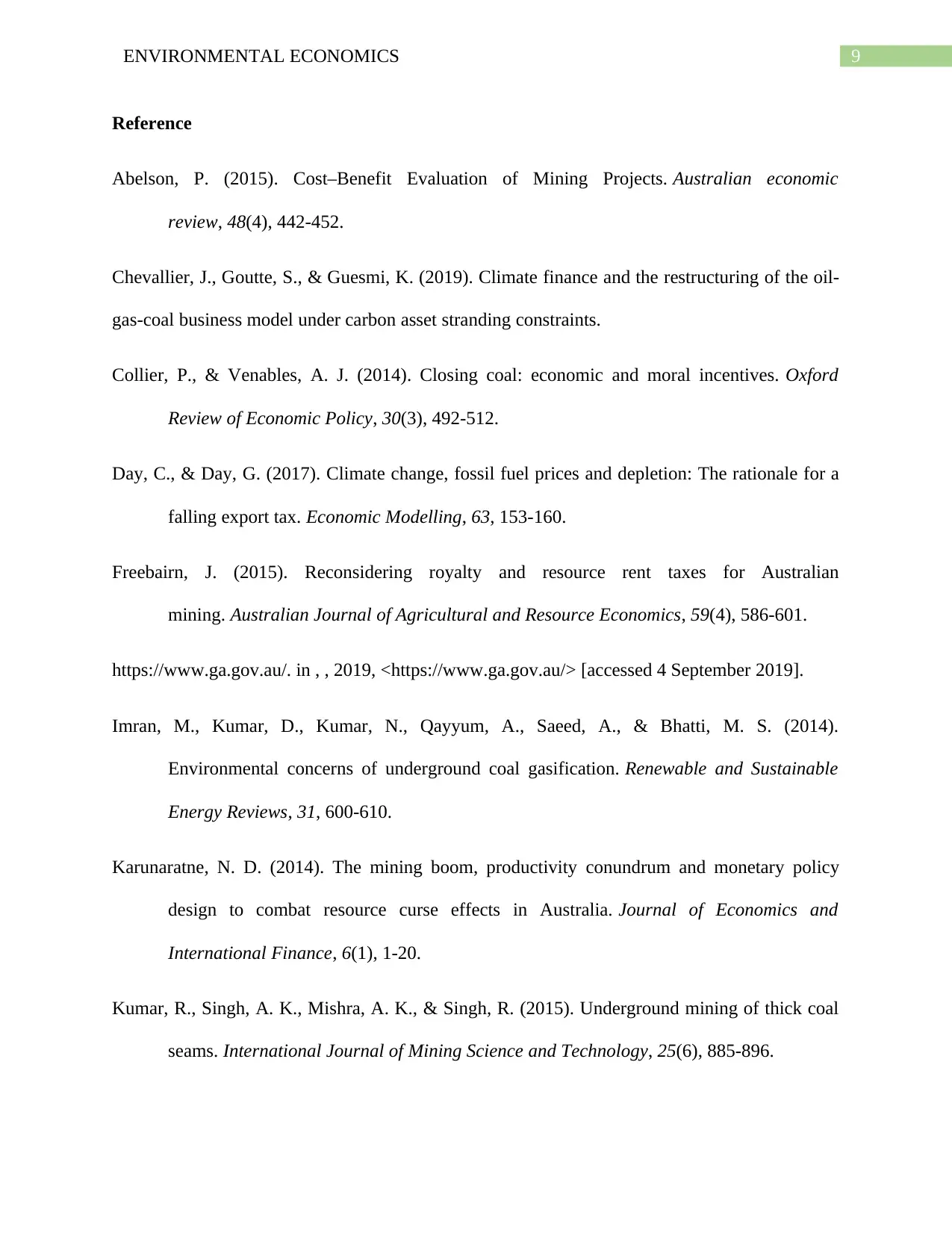
9ENVIRONMENTAL ECONOMICS
Reference
Abelson, P. (2015). Cost–Benefit Evaluation of Mining Projects. Australian economic
review, 48(4), 442-452.
Chevallier, J., Goutte, S., & Guesmi, K. (2019). Climate finance and the restructuring of the oil-
gas-coal business model under carbon asset stranding constraints.
Collier, P., & Venables, A. J. (2014). Closing coal: economic and moral incentives. Oxford
Review of Economic Policy, 30(3), 492-512.
Day, C., & Day, G. (2017). Climate change, fossil fuel prices and depletion: The rationale for a
falling export tax. Economic Modelling, 63, 153-160.
Freebairn, J. (2015). Reconsidering royalty and resource rent taxes for Australian
mining. Australian Journal of Agricultural and Resource Economics, 59(4), 586-601.
https://www.ga.gov.au/. in , , 2019, <https://www.ga.gov.au/> [accessed 4 September 2019].
Imran, M., Kumar, D., Kumar, N., Qayyum, A., Saeed, A., & Bhatti, M. S. (2014).
Environmental concerns of underground coal gasification. Renewable and Sustainable
Energy Reviews, 31, 600-610.
Karunaratne, N. D. (2014). The mining boom, productivity conundrum and monetary policy
design to combat resource curse effects in Australia. Journal of Economics and
International Finance, 6(1), 1-20.
Kumar, R., Singh, A. K., Mishra, A. K., & Singh, R. (2015). Underground mining of thick coal
seams. International Journal of Mining Science and Technology, 25(6), 885-896.
Reference
Abelson, P. (2015). Cost–Benefit Evaluation of Mining Projects. Australian economic
review, 48(4), 442-452.
Chevallier, J., Goutte, S., & Guesmi, K. (2019). Climate finance and the restructuring of the oil-
gas-coal business model under carbon asset stranding constraints.
Collier, P., & Venables, A. J. (2014). Closing coal: economic and moral incentives. Oxford
Review of Economic Policy, 30(3), 492-512.
Day, C., & Day, G. (2017). Climate change, fossil fuel prices and depletion: The rationale for a
falling export tax. Economic Modelling, 63, 153-160.
Freebairn, J. (2015). Reconsidering royalty and resource rent taxes for Australian
mining. Australian Journal of Agricultural and Resource Economics, 59(4), 586-601.
https://www.ga.gov.au/. in , , 2019, <https://www.ga.gov.au/> [accessed 4 September 2019].
Imran, M., Kumar, D., Kumar, N., Qayyum, A., Saeed, A., & Bhatti, M. S. (2014).
Environmental concerns of underground coal gasification. Renewable and Sustainable
Energy Reviews, 31, 600-610.
Karunaratne, N. D. (2014). The mining boom, productivity conundrum and monetary policy
design to combat resource curse effects in Australia. Journal of Economics and
International Finance, 6(1), 1-20.
Kumar, R., Singh, A. K., Mishra, A. K., & Singh, R. (2015). Underground mining of thick coal
seams. International Journal of Mining Science and Technology, 25(6), 885-896.
Paraphrase This Document
Need a fresh take? Get an instant paraphrase of this document with our AI Paraphraser
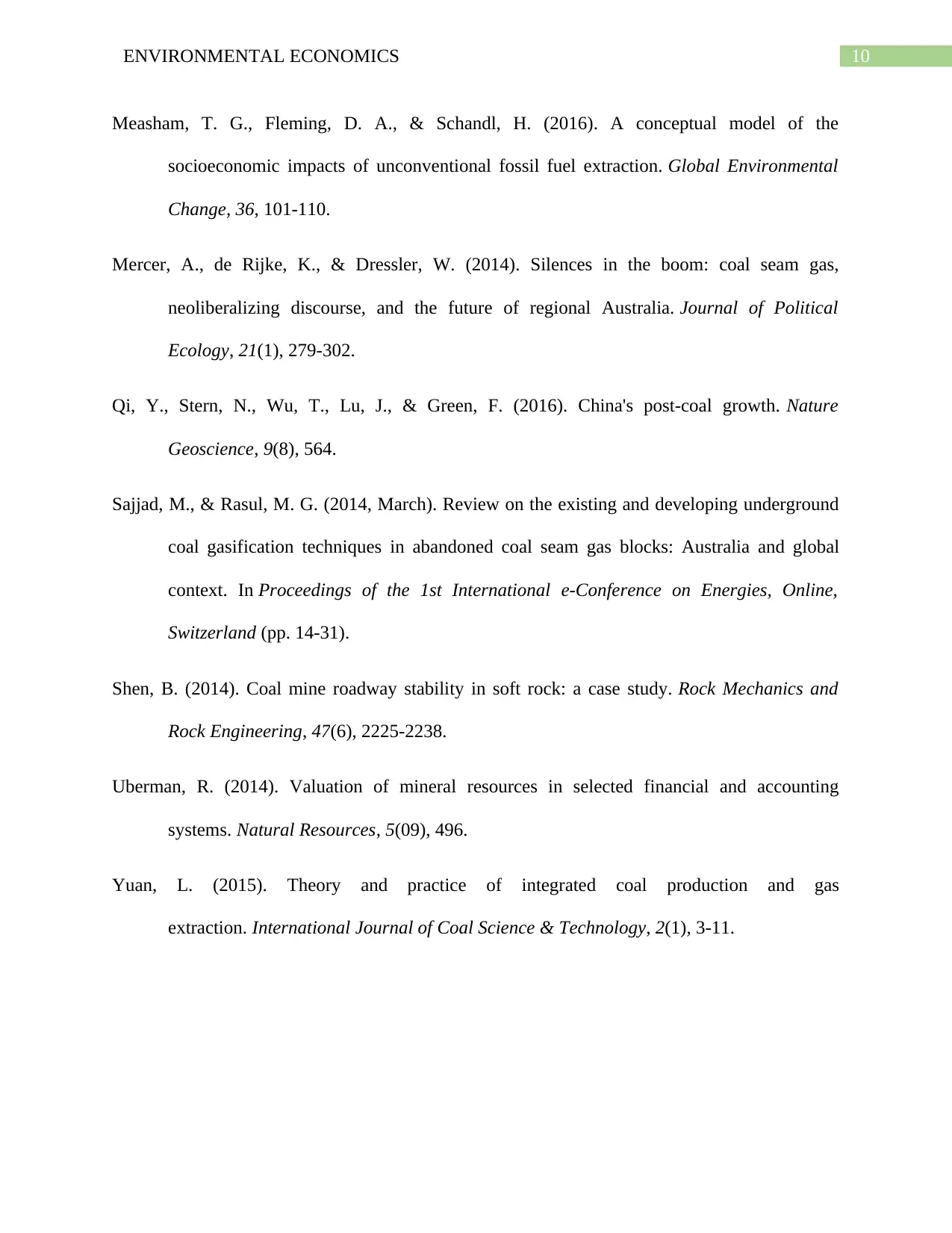
10ENVIRONMENTAL ECONOMICS
Measham, T. G., Fleming, D. A., & Schandl, H. (2016). A conceptual model of the
socioeconomic impacts of unconventional fossil fuel extraction. Global Environmental
Change, 36, 101-110.
Mercer, A., de Rijke, K., & Dressler, W. (2014). Silences in the boom: coal seam gas,
neoliberalizing discourse, and the future of regional Australia. Journal of Political
Ecology, 21(1), 279-302.
Qi, Y., Stern, N., Wu, T., Lu, J., & Green, F. (2016). China's post-coal growth. Nature
Geoscience, 9(8), 564.
Sajjad, M., & Rasul, M. G. (2014, March). Review on the existing and developing underground
coal gasification techniques in abandoned coal seam gas blocks: Australia and global
context. In Proceedings of the 1st International e-Conference on Energies, Online,
Switzerland (pp. 14-31).
Shen, B. (2014). Coal mine roadway stability in soft rock: a case study. Rock Mechanics and
Rock Engineering, 47(6), 2225-2238.
Uberman, R. (2014). Valuation of mineral resources in selected financial and accounting
systems. Natural Resources, 5(09), 496.
Yuan, L. (2015). Theory and practice of integrated coal production and gas
extraction. International Journal of Coal Science & Technology, 2(1), 3-11.
Measham, T. G., Fleming, D. A., & Schandl, H. (2016). A conceptual model of the
socioeconomic impacts of unconventional fossil fuel extraction. Global Environmental
Change, 36, 101-110.
Mercer, A., de Rijke, K., & Dressler, W. (2014). Silences in the boom: coal seam gas,
neoliberalizing discourse, and the future of regional Australia. Journal of Political
Ecology, 21(1), 279-302.
Qi, Y., Stern, N., Wu, T., Lu, J., & Green, F. (2016). China's post-coal growth. Nature
Geoscience, 9(8), 564.
Sajjad, M., & Rasul, M. G. (2014, March). Review on the existing and developing underground
coal gasification techniques in abandoned coal seam gas blocks: Australia and global
context. In Proceedings of the 1st International e-Conference on Energies, Online,
Switzerland (pp. 14-31).
Shen, B. (2014). Coal mine roadway stability in soft rock: a case study. Rock Mechanics and
Rock Engineering, 47(6), 2225-2238.
Uberman, R. (2014). Valuation of mineral resources in selected financial and accounting
systems. Natural Resources, 5(09), 496.
Yuan, L. (2015). Theory and practice of integrated coal production and gas
extraction. International Journal of Coal Science & Technology, 2(1), 3-11.
1 out of 11
Related Documents
Your All-in-One AI-Powered Toolkit for Academic Success.
+13062052269
info@desklib.com
Available 24*7 on WhatsApp / Email
![[object Object]](/_next/static/media/star-bottom.7253800d.svg)
Unlock your academic potential
© 2024 | Zucol Services PVT LTD | All rights reserved.





